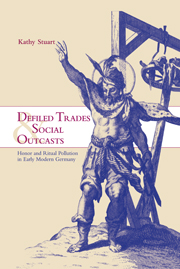Book contents
- Frontmatter
- Contents
- List of illustrations
- Acknowledgments
- List of abbreviations
- Glossary
- Introduction: defiled trades
- PART I THE MEANING OF DISHONOR IN EARLY MODERN SOCIETY
- PART II THE DISHONORABLE MILIEU
- 3 The status of executioners and skinners, 1500–1700
- 4 Living on the periphery of dishonor
- PART III PARADOXICAL DISHONOR: PUNISHMENT AND HEALING
- PART IV ARTISANAL HONOR AND URBAN POLITICS
- Conclusion: dishonor and the society of orders
- Selected bibliography
- Index
- CAMBRIDGE STUDIES IN EARLY MODERN HISTORY
3 - The status of executioners and skinners, 1500–1700
Published online by Cambridge University Press: 06 August 2009
- Frontmatter
- Contents
- List of illustrations
- Acknowledgments
- List of abbreviations
- Glossary
- Introduction: defiled trades
- PART I THE MEANING OF DISHONOR IN EARLY MODERN SOCIETY
- PART II THE DISHONORABLE MILIEU
- 3 The status of executioners and skinners, 1500–1700
- 4 Living on the periphery of dishonor
- PART III PARADOXICAL DISHONOR: PUNISHMENT AND HEALING
- PART IV ARTISANAL HONOR AND URBAN POLITICS
- Conclusion: dishonor and the society of orders
- Selected bibliography
- Index
- CAMBRIDGE STUDIES IN EARLY MODERN HISTORY
Summary
Who were Augsburg's dishonorable people? In the previous chapter we have considered under what circumstances contact between executioners and skinners and honorable citizens resulted in dishonor conflicts and under what circumstances they remained unproblematic. This entailed looking at the boundary of honor through the eyes of honorable society. We now change perspective to get an inside view. How did executioners and skinners experience dishonor? How did dishonor affect their legal, social, and economic status in Augsburg? We shall piece together the lives of individual executioners and skinners in the greatest possible detail, in order to reconstruct their social milieu.
By the early seventeenth century executioners and skinners had established a hereditary professional caste. One defining feature of this caste was a high degree of social endogamy. This endogamous marriage pattern has been well documented by the folklorists and historians who have studied dishonor. In contrast to artisans and other commoners who tended to marry locally, executioners and skinners often looked beyond their own locality to find marriage partners. Since there were usually only a small number of executioners' and skinners' children living in one city, they formed geographically extensive marriage networks. This peculiar marriage pattern has led one historian to compare the genealogical structure of executioners' dynasties with that of the aristocracy.
It is commonplace in the literature on dishonor to interpret this marriage pattern as a result of the social exclusion which executioners and skinners suffered at the hands of honorable society.
- Type
- Chapter
- Information
- Defiled Trades and Social OutcastsHonor and Ritual Pollution in Early Modern Germany, pp. 69 - 93Publisher: Cambridge University PressPrint publication year: 2000

